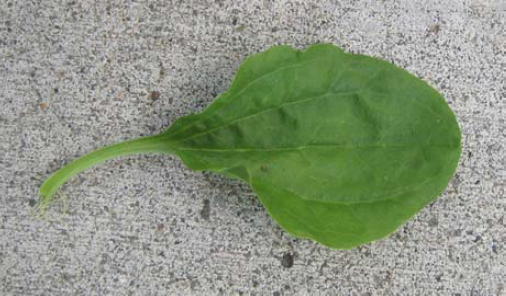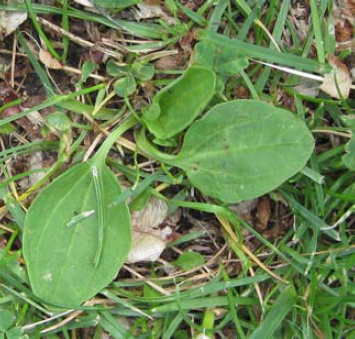Other common names
Common plantain, dooryard plantain
Scientific name
Plantago major
Family
Plantaginaceae
Description
A perennial that is a common pest of lawns and gardens, buckhorn plantain grows in a mound. It can be differentiated from buckhorn plantain by its wide, egg‐shaped leaves and long flower spike.

Typical plant growing in disturbed site.
Leaves
Oval to egg‐shaped with smooth or somewhat toothed and wavy edges. The leaves grow from the base of the plant on short, celery‐like stalks to form a rosette (round, ground‐hugging shape). They are about 2 to 7 inches long and have three or more prominent veins.

Stems
Very short, found only at the base of the plant.

The flowers are tiny and form on a long spike.
Flowers
Small yellowish‐white flowers form on a long spike attached to 5‐ to 15‐inch‐long leafless flowering stalks. Blooms from late spring to summer.
Roots
Fibrous and shallow; connected to a thickened, semi-woody base.

Young plants have broad, oval or eggshaped leaves with prominent veins.
Native to
Europe; naturalized throughout the United States
Where it grows
Roadsides, lawns, gardens, vacant lots, cultivated fields and other disturbed sites. Tolerates compacted and wet sites.
Life cycle
Perennial (grows back each year from the roots)
Reproduction
Produces seed and grows back from the roots
Control methods
Control of plantains can be difficult once they have become established, as plants can regrow from the crown. Continual monitoring and removal of new seedlings is essential to minimize spread.
Mechanical
Dig, hoe or pull repeatedly, removing as much of the root as possible. Use mechanical control methods prior to formation of flowers. Mulching with landscape fabric or more than 3 inches of organic mulch can be effective in controlling seedlings but is unlikely to control mature plants. Mowing is not effective, as plants will regrow and flower close to the ground.
Cultural
Plant desirable vegetation that will shade the area and reduce germination and growth of young plants. For infestations in turf, keep the grasses as healthy and competitive as possible by aerating, mowing high and watering properly. Prevent the spread of seeds by clipping blooms.
Biological
None.
Chemical
Apply broadleaf‐selective herbicides on young plants. Pre‐emergence herbicides can be used to manage existing seed banks.
References
All photos by S. Donaldson.
- DiTomaso, J.M. and E.A. Healy. 2007. Weeds of California and Other Western States. University of California Publication 3488.
- Elmore, C.L., D.W. Cudney and M.E. McGiffin. Jr. 2007. Plantains. UC ANR Publication #7478, IPM.
- USDA‐NRCS Plants Database. No date. Plantago major L., Common Plantain, USDA.
- Whitson, Tom D. (editor). 2002. Weeds of the West. University of Wyoming, Jackson, Wyoming.
Donaldson, S. and Hanson Mazet, W.
2010,
A Northern Nevada Homeowner’s Guide to Identifying and Managing Broadleaf Plantain,
Extension | University of Nevada, Reno, FS-10-17


